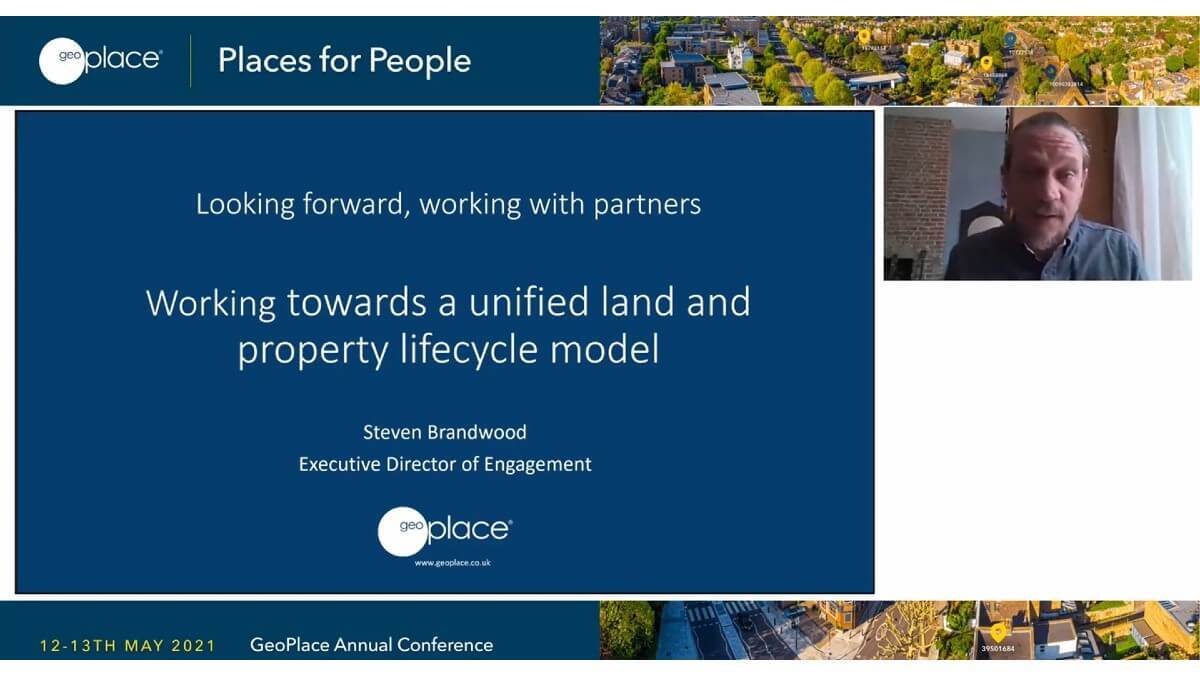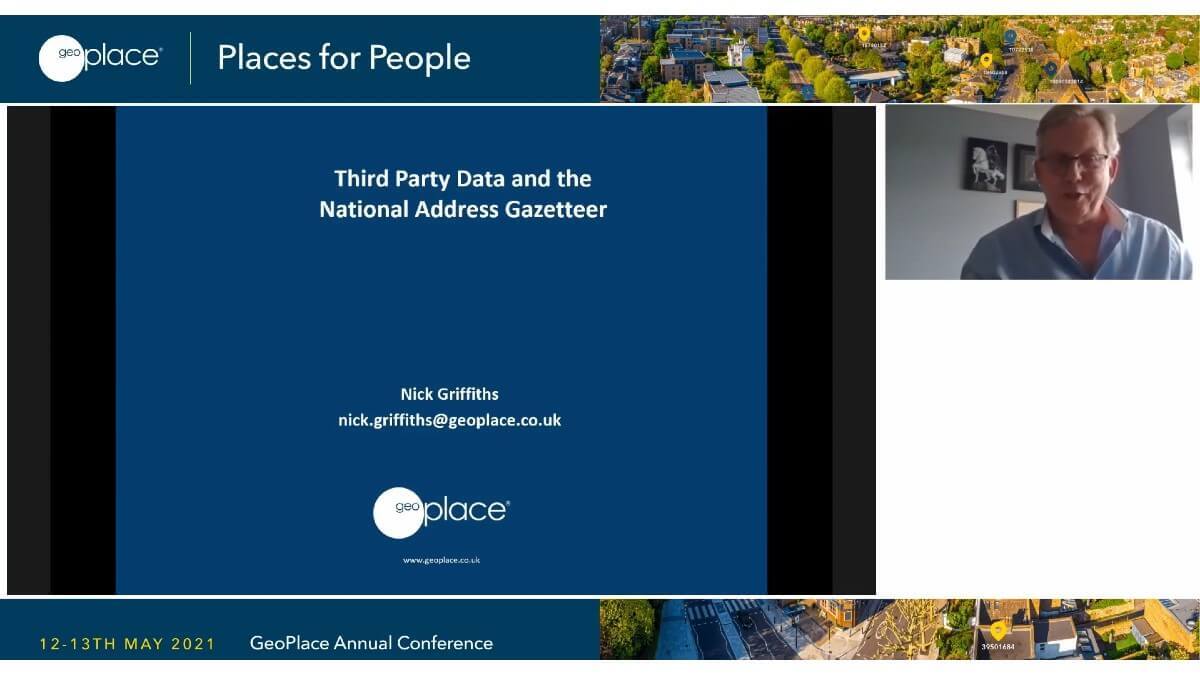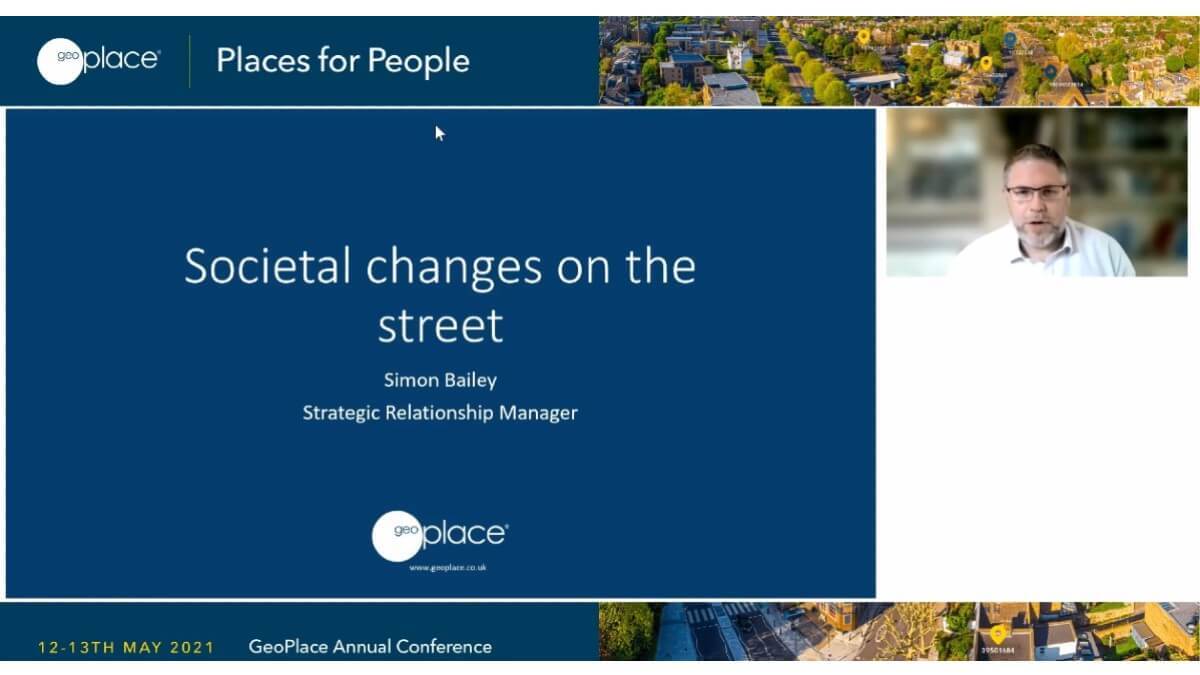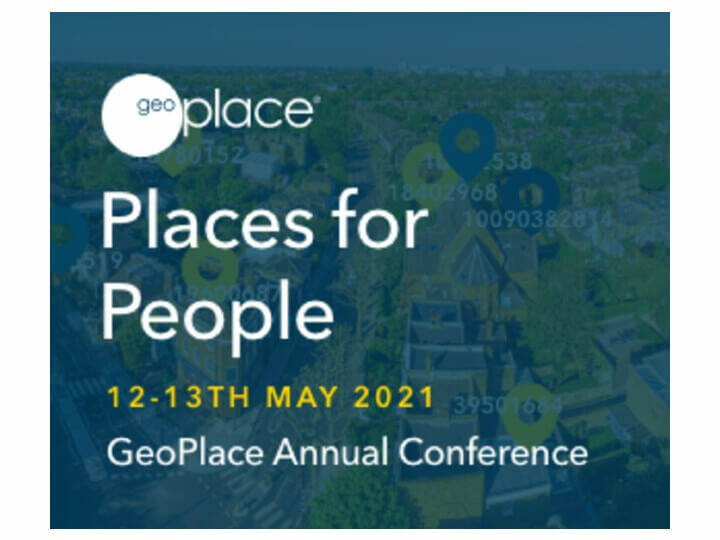Day 2, Session 3 - Explored the processes and partnerships that are helping to improve GeoPlace’s data, and ways in which working with external partners could be evolving. Street naming and numbering, Improvement Schedules, PSGA data asks, stakeholder engagement and third-party data are all vital inputs here.
Speakers included:
- Steve Brandwood, Executive Director of Engagement, GeoPlace
- Neil Griffiths, Executive Director of Informatics, GeoPlace
- Simon Bailey, Senior Strategic Relationship Manager, GeoPlace

Listen to the presentations here.
Steve Brandwood, Executive Director of Engagement at GeoPlace opened the session. In his role, working with local authorities, Steve works with key partners who contribute to the land and property data lifecycle. He iterated the value of building on previous speakers’ contributions, noting the importance of data that exists already in the land and property marketplace, and started by looking at the sector in general. Local authorities are the primary source of change information, and GeoPlace has been working with them for over 20 years in different ways, to manage change information as it comes through the system to ensure accurate, current, and granular data. Steve explained that the time is now right to pursue further integration with other partners to deliver a more unified land and property data lifecycle model.
Local authorities are the source for much of the information that’s needed – planning, for example, and naming streets and numbering properties – there are myriad control points that trigger control of use; in short, practically nothing should be built and occupied without local authority knowledge and approval. Over the years, GeoPlace has developed the Data Entry Conventions document – colloquially known as ‘the DEC’ – which provides the framework for capturing vital information and managing property lifecycle data. There’s a basic flow of information that’s derived from the construction process, for example. From the planning stage, through to designation and build; occupancy, through residents taking over responsibility for that property’s management; and finally into the deconstruction phase for a property, ultimately resulting in demolition. That accumulating intelligence is reflected in the Local Land and Property Gazetteers, and consequently in the National Address Gazetteer and in Ordnance Survey’s AddressBase products.
This lifecycle data is complex. It includes multiple combinations of the Basic Land and Property Unit (BLPU) logical status, the Land and Property Identifier (LPI) logical status, and the BLPU state itself in describing the property’s current position in that lifecycle and process. In addition, there have been varying approaches to adding records into the Gazetteers, depending on reserved matters for example and the exact date on which construction might begin; and there is a need to consider the provision of ‘live’ postcodes rather than reflecting the intelligence gathered as part of the street naming and numbering process – all of these conventions are reviewed regularly, and it feels as though the time is right now to review the DEC with those complexities in mind.
With that in mind, GeoPlace has been considering how the street naming and numbering process might be the key trigger in the promotion of ‘Good Addressing’, and a code of practice will be published in 2021. This will contain analysis of current legislation; authorities’ responsibilities and duties; and best practice for good addressing, as we move towards greater standardisation. To support this work, GeoPlace has been working alongside the location data communities and running working groups that can help bring vital information together – but there’s more to land and property than street naming and numbering and, in its purest form, ‘good addressing’.
Other bodies play an important part in this lifecycle by signalling potential changes, and by providing more attributes along the way. Whether or not the property receives post, for example, and how much it is worth. These organisations include HM Land Registry, the Valuation Office Agency, Royal Mail, and Ordnance Survey. There has been a significant amount of work over the last two decades, looking at how these organisations work together.
In the last 10 years, this has included the embedding of local authority data maintenance; increasing trust in data quality; changes to what was the Public Sector Mapping Agreement and One Scotland Mapping Agreement arrangements and, through the work of the Geospatial Commission, the emergent Public Sector Geospatial Agreement (PSGA); valuable lessons learned from Covid, and the influence of now living in a data-driven society. However, GeoPlace is keen to increase the momentum, and to involve these organisations even more in the data capture processes and the attribute-and-lifecycle journey overall, and to adopt the Unique Property Reference Number (UPRN) as part of their own registration processes. This will provide greater efficiency for the conveyancing process overall. GeoPlace is also looking at the data surfacing around changes in property use, and how that granular detail might be better captured for the benefit of both private and public sector services.
There is a huge opportunity to work in a more collaborative, joined-up way, which will not only increase the speed of the conveyancing journey but provide great value to society too, in the form of further inter-agency efficiencies. The focus for government, moving forwards, will reflect the sentiments of the Queen’s Speech: looking at the levelling-up agenda, voter ID, health and social care, housing and planning and infrastructure – but all of these aspects of our lives will improve, and outcomes will be easier to achieve, if agencies working with land and property are exchanging, creating, and managing data as efficiently as possible.
Local authorities sit within this connected web of functions. They include planning, land charges, taxation, planning – and the UPRN acts as the golden thread, throughout all of these functions; it enables data sharing between partners, it enables the market to aggregate data and build services more efficiently and effectively. Steve iterated the value of using the UPRN in this context, and also highlighted the availability of GeoPlace’s UPRN Integration Assessment Tool. Integration will provide the backbone for significant economic growth; the more organisations that adopt AddressBase and play their part in developing the underlying data processes, the more value will be derived. Accurate and up-to-date data drives service transformation, and linked data opens up a world of new opportunities for everyone to benefit from the power of location data. UPRN consistence will be crucial of course, as will the adoption of UPRNs into national data sets on a wider basis.
In terms of day-to-day activity for GeoPlace, the focus will still be on street naming and numbering as a catalyst for good addressing; working with Royal Mail to help streamline the postcode allocation process; working with HM Land Registry and with the Valuation Office Agency, but there will also be opportunities to work more closely with several other central organisations – encouraging cohesive consistency throughout the land and property lifecycle.

Nick Griffiths, Executive Director of Informatics at GeoPlace followed on from Steve, iterating the value of using the UPRN but also driving straight to the heart of the location agenda – noting that GeoPlace is constantly checking the National Address Gazetteer, and constantly encouraging organisations to take full advantage of the attributes therein.
The GeoPlace team has tried and tested processes in place, that enable them to look at any address-related data, and derive greater value from it. Identifying sources, accessing them, cleaning them – standardising the attributes – reformatting them to make them usable, and identifying anomalies. There’s no such thing as a perfect dataset; test records and legacy records all play their part. However, as the team reviews the data, it can also talk to the originators’ communities to help improve data quality as early as possible in that information’s lifecycle. Perhaps by contacting a local authority to discuss a particular data entry problem for example, but also talking to core organisations such as Ministry of Housing, Communities and Local Government and the Department for Education, identifying and challenging anomalies ‘at source’.
Working out the best way forward usually involves focusing on core objects. For the most part, this process begins by looking at the result of third parties’ data analysis – collaborating with local authorities, and bringing the value of this cleansed data to the surface. With pharmacies, for example, in the current health climate, it has been important to look at how those businesses are classified within the AddressBase suite of products. GeoPlace has been looking at the possibilities around those businesses’ classifications, which would enrich datasets with useful information that could be used by both the private and public sector.
GeoPlace works closely with local authorities, processing and reviewing over 59.3 million records on a regular basis. GeoPlace has also been looking at new 63.6 million records and their sources (Government open data, commercial data sets, and data that’s been made more widely available by third parties using the internet), with a view to using that data to enrich core datasets even further. This includes datasets that are published by NHS Digital; NHS Wales; Energy Performance Certificates published by MHCLG; HM Land Registry’s price paid data; the Gaming Commission; HM Passport Office; the Food Standards Agency, and Royal Mail. All of this work goes on daily, in addition to ad hoc requests for core information – particularly in recent times, where queries for health-linked data have been more frequent.
Nick noted that, as a point of interest, much of the data published by central Government is in fact administered by local authorities, in many cases with a statutory role as the licencing body. Things like drinking and gambling, care homes, premises used for food preparation, caravan sites, scrap yards etc. He raised the thought-provoking point, that instant efficiencies are available – life-changing, risk-reducing, money-saving efficiencies - if all of these datasets ‘left’ each local authority, with the UPRN already embedded as the single point of truth.
GeoPlace’s collective mission is to facilitate bringing together local authority processes and datasets with third party datasets, via the UPRN. To help improve those local authority processes; to maintain and indeed, extend, the National Address Gazetteer and its derived OS AddressBase products; and to ensure widespread adoption of the UPRN and NAG addresses throughout central government processes and data sets.

Simon Bailey, Senior Strategic Relationship Manager at GeoPlace, picked up this theme in his presentation on societal changes on the street. The themes and drivers can be summarised into two parts: use of the highway, and the infrastructure in it.
Many, if not all, of the activities he picked up use GeoPlace’s data as their core reference point, enabling multi-agency collaboration in a number of ways. As one example, Simon talked through the advantages being seen through the nationwide rollout of fibre broadband, reflecting the needs outlined in the 2018 National Infrastructure strategy. The aspiration is that everyone in the UK will have access to gigabyte broadband by 2033, 85% of the population by 2025 and 100% by 2033. Alongside this work, the 5G rollout is also moving forward quickly, looking at part in using street assets, such as lamp posts, as relay points. Much of the work in both cases relates to the physical location of the street and to the valuable assets on that street.
In addition, the nation’s focus is on the transition to cleaner energy, meaning there has been a significant momentum over the last few years in the growth of electric vehicles; 50% of all new cars being sold are expected to be electric by 2030, with 100% due to be electric by 2050. Almost every car and van on the road is expected to be creating zero emissions by that point, and this means the nation needs to move from the current 23,000 charging points to over 2.3 million by 2030 (1.9 million of those on the street). At this level we need over 700 installations a day, currently this is only 42.
Funding has been made available to facilitate this transition, but there are knock on effects for many businesses and organisations, including GeoPlace, which needs to capture all of the new data that’s being generated to give a true picture of the charge point network.
In the same vein, there is also progress with trials around Connected Autonomous Vehicles, which will need to understand and interact with the infrastructure around them. This might mean changes to the street network, to registers that hold information about asset conditions, and to capture of real-time road condition. Again, this data will all depend on having interoperable points of reference, and this is where the value of the Custodians will play a crucial part.
Another nationwide project that depends on consistent accurate data, is the proliferation of district heating schemes – aiming to help meet the UK’s emissions’ pledges. 18% of our homes’ heating will need to be provided by heat networks, by 2050. This along with, a better understanding of our energy network is being looked by various groups such as The Energy Data Taskforce and the Energy Networks Association who are working on the National Energy System Map, and the Geospatial Commission with the National Underground Asset Register (NUAR). Much of these networks fall in the highways and GeoPlace sees the USRN (Unique Street Reference Number) as being the key to facilitate accurate asset mapping.
Other external influences include the removal of highway clutter, work on noise and light pollution, and other factors that impact the quality of life – such as using roads differently with promotion of cycling and walking and the impact of recent increase in ‘home delivery services’. The pandemic forced a significant drop in use of the road network – 24.7% down compared to the previous year – but light vehicles, such as vans, contributed to 18% of traffic in 2020, compared to 16% in 2019 and only 10% in 1994. This points to an increasing reliance on home deliveries and ‘last mile services’, with online retail accounting for 35.2% of sales compared to 19.5% in 2020. With all of these factors in mind, GeoPlace’s data – and the contributing work of local authorities – will have an impact on:
- Installation and improving assets
- Coordinating streetworks on the network
- Understanding the change in use of the network – its design and maintenance
- Monitoring the changes and impact of those different users on the network, and,
- Ensuring interoperability among as many stakeholders as possible.
The appetite for clean, accurate, granular data is growing. With the publication of the National Data Strategy, the focus is rightly on format; interoperability; currency; accessibility and accuracy. But we also know the value on continuously improving quality and reliability, and on the collection (and use) of better metadata and associated data. For GeoPlace, this means a strong emphasis on working with partners to build frameworks that align with the gazetteers, getting local authorities involved in the solutions, and ensuring both the Unique Property Reference Number and the Unique Street Reference Number are adopted as widely as possible.


